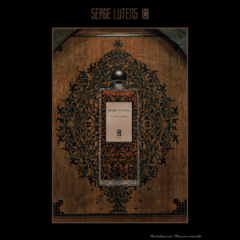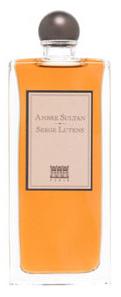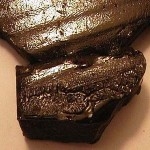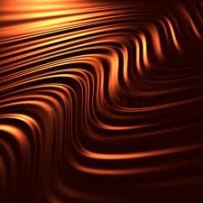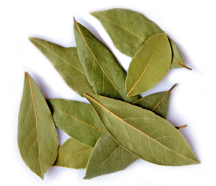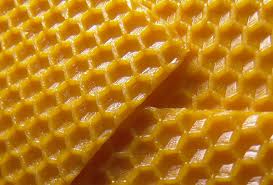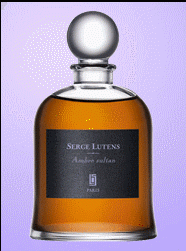Serge Lutens tells you up front to expect something different:
This fragrance is not an Oriental, but an Arab and a Lutens. That being the case, don’t expect it to fit in. [Emphasis added.]
He’s right. For a large number of people, Ambre Sultan is not a typical amber, and some get a small shock upon first sniffing it. They expect something soft, cozy, sweetly vanillic, and gentle, but end up with a very herbal, almost medicinal, fragrance in the beginning.
I had a different experience, however, and it was a far cry from the “Chinese medicine” or “herbal spice shop” amber that I had expected. Yes, it was there to a minuscule, muted degree, but it lasted less than ten minutes and it was hardly a predominant aspect of the fragrance. Instead, on my skin, Ambre Sultan was primarily a labdanum and beeswax fragrance. It’s very nice, but it’s not the amber of my heart, and I don’t share in the view that it is the best, richest amber fragrance around.
Ambre Sultan is an eau de parfum that was created with Lutens’ favorite perfumer, Christopher Sheldrake, and that was originally released in 1993 before becoming available worldwide in 2000. The remainder of Serge Lutens’ description quoted up at the top is really key in understanding the perfume, in my opinion:
The point of departure was a scented wax, found in a souk and long forgotten in a wooden box. The amber only became sultanesque after I reworked the composition using cistus, an herb that sticks to the fingers like tar, then added an overtone that nobody had ever dreamed of: vanilla. Why? Because vanilla is sticky, too, and it clung to my memory.
As usual, Uncle Serge provides no notes for the perfume, but Fragrantica says that they consist of:
coriander, bay leaf, oregano, angelica, resins, myrrh, amber, myrtle, sandalwood, patchouli, benzoin and vanilla.
Fragrantica leaves out the most important part: the cistus or labdanum discussed by Serge Lutens. It’s not accurate enough, in my opinion, to just mention “amber” because, to me, labdanum is a whole other creature. The three main resins generally used in oriental fragrances to create the amber smell are: labdanum, ambergris, and benzoins. (Tolu Balsam is another, but it’s not so common.)
Labdanum has a very specific, intense aroma that is nothing like the general, more commercial, easy “amber” mélanges found in many scents. It’s much more masculine with a nutty, toffee, darkly syrupy, sticky, honeyed, sometimes leathery aroma that is almost dirty in nature. It can also be very animalistic on occasion, and frequently musky; in many cases, it can feel almost raw, at least relative to the generic ambers used in some perfumes. Dark brown, verging on black in colour, labdanum is the heart of some of the most-beloved, oriental amber perfumes, from Dior‘s Mitzah and Amouage‘s Opus VI, to Puredistance‘s M and Tom Ford‘s Amber Absolute.
The very particular, very unique aroma of labdanum is the opening, middle, and end of Ambre Sultan on my skin. The perfume opens with a very boozy, resinous blast of labdanum with all its nutty, dirty, toffee’d, slightly honeyed, sticky, vaguely leathered undertones. It is accompanied by a subset of the honey note which usually emanates from labdanum and which, here, is all about the beeswax. The overall impression is that cognac, rum, toffee, something almost verging on nutty chocolate, and the beeswax from a large hives of bees all got together for a boozy orgy, resulting in the lovechild that is Ambre Sultan. I absolutely love it.
All too quickly, however, the perfume loses some of its sticky, resinous sweetness, thanks to the subtle infusion of dried, green herbs. They’re led by bay leaf in particular, and the aroma is initially as strong as one of those over-sized, chef jars that contains hundreds of the dried ingredient. There is the faintest touch of oregano that follows in its trail, but it’s brief and quickly flitters away. Far, far below, in the base, there is a subtle, very muted, tarry note that almost verges on the camphoraceous, but which never quite gets to the eucalyptus point on my skin. Like the oregano, it too quickly disappears. Much more prominent, however, is the subtle smokiness in Ambre Sultan that dances all around the edges. It doesn’t feel like true incense but, rather, like the smell of burning leaves in autumn.
Accompanying it in the background is an unusual musty, earthy, dustiness. It’s a strange note because it really evokes the feel of some ancient artifact or parchment that had been left at the bottom of an old spice drawer for seventy years. It’s as much earthy as it is dusty and, when combined with the strong beeswax vein running through Ambre Sultan, it really and truly evokes what Serge Lutens intended: “a scented wax, found in a souk and long forgotten in a wooden box.”
The quiet dryness of all these notes, along with the extremely muted veil of herbs, helps to ensure that Ambre Sultan’s sticky, resinous character never verges into the cloyingly sweet or the unctuous. Yet, I’m truly surprised by how minor, light and hidden that green veil is on my skin. I don’t get a blast of myrtle with its medicinal, eucalyptus aroma; there is no angelica with its common celery nuances; the bay leaf disappeared in about 5 minutes; and the oregano was never more than a momentary flicker.
Instead, Ambre Sultan quickly devolves into a very simple, completely linear, and, ultimately, if I dare say it, somewhat boring combination of labdanum and beeswax. Yes, there are subtle nuances of smokiness and minor muskiness. Yes, there eventually is some vanilla that is faintly powdered and which arises at the very, very end. But, on my skin, Ambre Sultan is just nutty, slightly toffee’d, vaguely honeyed labdanum with its sidekick, the beeswax. It’s like the Lone Ranger and Tonto. They ride side by side for hours on end, with the slightly honeyed beeswax temporarily pulling slightly ahead around the end of the third hour, but it’s mainly just the two of them for most of the journey. No sandalwood, no patchouli, no herbs — nothing.
The only change in Ambre Sultan is in degree and sillage. Less than one hour into its development, the perfume softens, becoming milder, warmer, and tamer. At the 90-minute mark, Ambre Sultan starts to become blurry at the edges; it feels more like a vaguely nebulous, gauzy bouquet of labdanum and beeswax. It hovers just barely atop the skin, but the sillage decreases even further. Thirty minutes later, at the two-hour mark, Ambre Sultan turns into a complete skin scent. It is becoming increasingly hard to delineate beyond the two main notes that have now blurred together as one. Eventually, however, around the end of the sixth hour, the vanilla and benzoin start to slowly stir in the base, joining the main players in a very muted, hazy form. It’s a lovely, cozy drydown bouquet of sweet, barely resinous, generally amorphous, nutty amber with vanilla, lightly flecked by beeswax. In Ambre Sultan’s final moments, the perfume is nothing more than a faint trace of vanilla with a subtle nuance of powderiness. All in all, it lasted just 7.5 hours.
I liked Ambre Sultan, but I know my lack of exuberance is showing. So, I think it’s really important to put my reactions into a context here. I love massively resinous, spicy amber perfumes, and I’ve tried a lot of them. I think that, perhaps, I had heard a little too much about Ambre Sultan, and that my expectations were a little too high. I also think that my reaction would be very different had I smelled Ambre Sultan at the start of my journey to cover seemingly every amber or amber oriental perfume around. Had I done so, I would probably have been more blown away. As it is, I fear Ambre Sultan is getting the shaft by being compared to other fragrances I’ve tried that are considerably more intense, be it Tom Ford‘s Amber Absolute, or the stunningly rich, dense, concentrated Profumum line of Ambra Aurea and Fiore d’Ambra. By my personal, admittedly peculiar, and distorted standards of richness, I find Ambre Sultan to be light, airy, and safe. I realise that a lot of people consider it to be one of the richest, spiciest ambers around. But then, they also say that about Parfum d’Empire‘s Ambre Russe, too — and I thought that one was so sheer and anorexic that it might as well be an eau de toilette. So, clearly, I have a very different measuring stick than most.
Yet, despite my admittedly uncommon views on what constitutes richness versus lightness, I’m not completely alone in finding Ambre Sultan to be tamer than anticipated. Olfactoria’s Travels had the same reaction, and her review encapsulates many of my feelings about the perfume:
Usually, light or subtle are not adjectives one would immediately associate with a Lutens creation. And not that Ambre Sultan is either of these traits, but it is way less than what I was expecting in volume.
I thought an amber fragrance from our dear Serge would blast me clean out of my boots, to put it mildly. What I got was a purring kitten, sleeping in my lap, spreading its warmth, not a roaring tiger that is out to have me for dinner.
Ambre Sultan is a gorgeous perfume, an amber to love, an amber to cherish, an amber perfect in its execution, but it does not pack a punch like Annick Goutal Ambre Fetiche, Armani Privé Ambre Orient, Parfums d’Empire Ambre Russe or Tom Ford’s Amber Absolute, it is a lot subtler and lower in volume.
I would not make that much of a fuss, were it not a Serge Lutens perfume. You just come to expect certain things and when they are not met, there is a kind of disappointment, that is not necessarily rational or justified. But it is there nonetheless. […][¶]
Things would be different had I come from the other side. Never having smelled an amber scent like the ones mentioned above, would probably have resulted in a different view.
Despite that initial disappointment, Olfactoria (or Birgit) grew to love the scent, finding it “erotic” and “deeply sexy.”
I part ways with her there. I find Ambre Sultan to be cozy and safe, verging a little on the uninteresting, given the way that it manifested itself on my skin. It’s surprisingly boring and linear for a Lutens, too. But perhaps my heart is simply too taken by Profumum’s Ambra Aurea with its gloriously different focus on pure ambergris — in the most enormous, expensive quantities imaginable — resulting in a smoky, sultry, endlessly smooth, insanely concentrated fragrance that I couldn’t get out of my head. (I cannot wait for my 30 ml decant to arrive!)
Still, if you’re new to amber, please don’t let me stop you from trying Ambre Sultan. It’s a great amber fragrance that is surely bound to be very satisfyingly rich for you. As the perfume critic, Tania Sanchez, writes in her four-star review in Perfumes: the A-Z Guide, Ambre Sultan essentially pioneered the way for all the amber fragrances which later ensued. It started the trend when it was originally released in 1993, and has been hotly copied ever since. As she says, “[w]hat distinguishes Ambre Sultan in this now-crowded arena is a high dose of fantastic dried-herb smells, which give it, in the top, a dusty, salty, outdoor air, before the more familiar vanillic-balsam plot takes over.”
My only word of caution — and it is a strong one, indeed — pertains to those distinguishing herbs. My skin amplifies base notes, so I didn’t get a lot of the herbal blast at the top, but you should expect it unless your skin is like mine. Some people really cannot stand the bay leaf, while others struggle with the oregano, or find the overall combination to evoke medicinal images. For example, on one Basenotes thread, some of the negative reviews consist of the following:
- I was very excited to try this fragrance…. applied some on my wrist and took a sniff!!! oh oh! I don’t like this one that much… this smells like the Chinese medicine that my mom used to give me as a kid when I have an upset stomach… this smells like coriander with some Chinese herbal medicine.
- I like the ambre basenotes but not the kitchen spices in the opening.
- Yeah I feel the same way. It smells like awkward mint. Like eating a weird foreign dish full of spices and then chewing gum. Bleh
- I actually hate this fragrance, it turned me off to amber for a while..the herbal was more than I could stand and after a few hours I actually felt sick. About the most unpleasant experience I’ve had with a fragrance.
Those comments are in the minority, however, as many, many people adore Ambre Sultan. There are extremely positive reviews in that same thread, as there are on Fragrantica where some gush in all-caps about their love for Ambre Sultan, or write:
- If I can only have one perfume, this will be it. The opening is quite strong but then as it dies down, a warm comforting amber cocoons your surrounding.
- Normally I have no desire to sit in the smoke direction by a campfire. But this fire has the most amazing smoke. The wood on the fire is pure sandalwood. An amazing hot, smoky, spicy perfume. Makes me quite warm. Check me in as part of the harem of Ambre Sultan’s Palace.
- If I close my eyes I envision myself in an exotic bazaar, the air filled with heavy incense, spices, and herbs and after thoughts of men’s colognes. Ambre Sultan, fit for a king, worn by a woman.
There are many more in that same vein. As I said, Ambre Sultan is one of the most popular amber fragrances around. But, if herbs are not your cup of tea, then you can always try to hunt down Tom Ford’s now discontinued Amber Absolute or his new Sahara Noir (which I found to be incredibly similar to Amber Absolute on my skin, only with oud.) Or, if you want the glory that is true ambergris (as opposed to labdanum or just regular, plain “amber”), then try Profumum’s Ambra Aurea, and be prepared to have your socks knocked off. No herbs, no spices, no complications — and it leaves all the others in the dust, in my admittedly biased opinion.
Still, if you want a different take on ambers, give Uncle Serge’s pioneering vision a chance. You may enjoy his soft, fragrant, herbal trip to a Moroccan souk.

